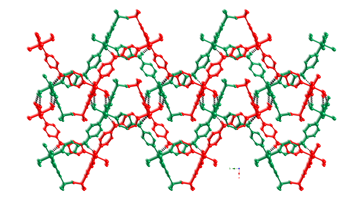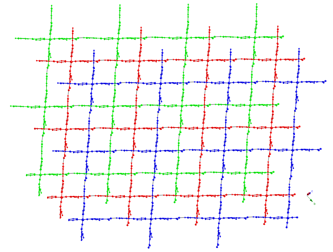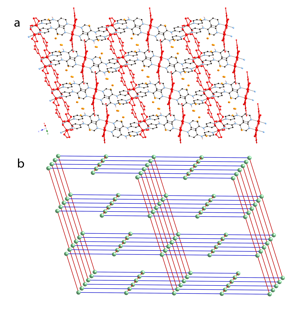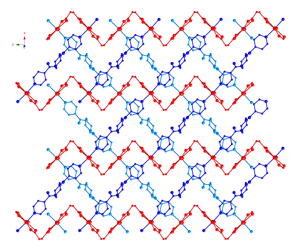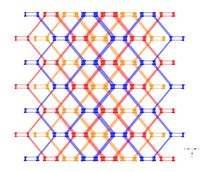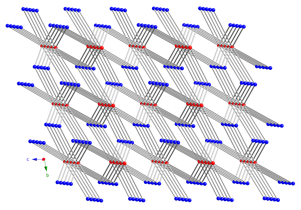57th Annual Report on Research 2012 Under Sponsorship of the ACS Petroleum Research Fund
Reports: B348311-B3: Synthesis, Structural Determination, and Physicochemical Property Studies of Novel Coordination Polymers Incorporating Kinked and Hydrogen-Bonding Capable Bifunctional Organodiimines
Robert L. LaDuca, Michigan State University
Over the past year the undergraduate-only LaDuca research group has explored the synthesis, structural characterization, and physical property investigation of divalent metal dicarboxylate coordination polymers containing hydrogen-bonding capable and flexible tethering dipyridyl ligands.
During the timeframe September 201 1 to August 2012, the group published 10 articles. Productivity over previous grant years was diminished because of the PI's open heart surgery and subsequent months' long recuperation. Six students worked on this project as part of independent study courses, with supplies and analysis costs borne by the grant. One student, Jacob Uebler, received a small part of his summer stipend from PRF funding. Four of these six students were female; one of these women is a member of an under-represented minority group (Lestella Bell). Amy Pochodylo wrote nearly all of an invited manuscript that was accepted by Inorganica Chimica Acta for a special commemorative issue in honor of the PI's postdoctoral advisor Jon Zubieta. The PI and his former student Gregory Farnum were the recipients of the inaugural Award for Undergraduate Research in Inorganic Chemistry sponsored by the ACS DIC. They attended the ACS National Meeting in Philadelphia in August 2012, with Gregory delivering a very good award talk summing up his 2 years of undergraduate research, which resulted in twenty-two peer reviewed publications.
The undergraduates were deeply and independently involved in every aspect of the work: organic synthesis of the dipyridyl ligands, low- and high-temperature inorganic synthesis, single crystal X-ray crystallography, molecular graphics rendering, variable temperature magnetic susceptibility studies, fluorescence spectroscopy, and thermogravimetric analysis. It is clearly evident that all students developed laboratory and analysis techniques during their time in the research laboratory. Perhaps more importantly, they developed these capabilities while investigating new science, not well-worn procedures.
The PI does not host any graduate students or postdoctoral fellows, because of his unique appointment within Lyman Briggs College at Michigan State University (an under-graduate-only residential college for the study of science and its impact on society). Thus the advancement of his research program depends critically on the hard work of these undergraduates.
Much of the research carried out in the 2011-2012 reporting period involved the synthesis, structural characterization, and physical property measurements of divalent metal coordination polymers incorporating the seldom-used long-spanning and hydrogen-bonding capable dipyridyl ligands bis(4-pyridylformyl)piperazine (bpfp) and 4,4¢-dipyridylamine (dpa). The hydrogen-bonding and ligating ability of the formyl groups in bpfp, along with its ability to adopt cis and trans formyl group conformations, has led to dramatic differences in coordination polymer dimensionality and topology. It is not possible to present all of the group's results for the year in this limited space, so only highlights from higher impact journal publications will be given.
Hydrothermal synthesis has afforded four divalent metal coordination polymers containing the aliphatic tricarboxylates tricarballylate (tca) or trans-aconitate (acon) and the kinked tethering co-ligand 4,4¢-dipyridylamine (dpa). Diverse structural topologies are evident across this series, with coordination geometry and carboxylate binding mode serving important structure-directing roles. {[Cd2(tca)2(Hdpa)2]¥7H2O}n (1) possesses 1-D ribbon motifs with pendant Hdpa+ ligands and a new 4-connected supramolecular topology, along with co-crystallized water molecule tapes. {[Cd3(acon)2(dpa)2(H2O)2]¥4H2O}n (2) has a 4,4-connected binodal lattice with frl (4264)4(6482) topology, while the structurally related phase {[Zn3(tca)2(dpa)2]¥2H2O}n (3) has a 4,4-connected binodal lattice with a novel (426282)4(6284) topology. [Cu(Htca)(dpa)]n (4) manifests a 3,5-connected binodal net with rare (4.62)(4.6683) topology.
1 |
2 |
3 |
|
4
|
Hydrothermal synthesis has afforded cobalt 5-substituted isophthalate complexes with 4,4¢-dipyridylamine (dpa) ligands, showing different dimensionalities depending on the steric bulk and hydrogen-bonding facility of the substituent. [Co(tBuip)(dpa)(H2O)]n (5, tBuip = 5-tert-butylisophthalate) is a (4,4) grid two-dimensional coordination polymer featuring 2-fold parallel interpenetration. [Co(MeOip)2(Hdpa)2] (6, MeOip = 5-methoxyisophthalate) is organized into 3-fold parallel interpenetrated (4,4) grids through strong N–H+¥¥¥O– hydrogen bonding. {([Co(OHip)(dpa)(H2O)3])3¥2H2O}n (7, OHip = 5-hydroxyisophthalate) possesses 1-D chain motifs. The 5-methyl derivative {[Co(mip)(dpa)]¥3H2O}n (8, mip = 5-methylisophthalate) has a 3-D 658 cds topology. {[Co(H2O)4(Hdpa)2](nip)2¥2H2O} (nip = 5-nitroisophthalate) and {[Co(sip)(Hdpa)(H2O)4]¥2H2O} (sip = 5-sulfoisophthalate) are simple coordination complexes. Antiferromagnetic superexchange is observed in 5 and 8, with concomitant zero-field splitting.
5
|
|
6
|
|
7
|
|
8
|
Hydrothermal synthesis has generated a series of luminescent cadmium aliphatic dicarboxylate coordination polymers containing the multitopic bis(4-pyridylformyl)piperazine (bpfp) neutral ligand. {[Cd(suc)(bpfp)(H2O)]¥2H2O}n (9, suc = succinate) has a simple yet very rare 4-connected 658 layered topology. {[Cd(dmg)(bpfp)(H2O)]¥H2O}n (10, dmg = 2,2-dimethylglutarate) also shows a 4-connected net, but with a 3-fold interpenetrated sra 42638 topology. {[Cd(Hemg)2(bpfp)(H2O)]¥2H2O}n (11, emg = 3-ethyl, 3-methylglutarate) is a simple 1-D chain coordination polymer. {[Cd2(adp)(bpfp)2(H2O)2](ClO4)2¥2H2O}n (12, adp = adipate) has {Cd2O2} dimeric units linked by adp and exotridentate bpfp ligands into a rare (3,8)-connected tfz-d binodal topology. The oxoanion free derivative [Cd(adp)(bpfp)]n (13) shows a non-interpenetrated 6-connectd pcu topology.
9
|
|
10
|
|
11
|
|
12
|
13 |
Work continues in our laboratory in this fertile research vein. While the project has borne significant scientific fruit and has resulted in numerous publications, the intellectual and personal development of the undergraduates involved in the research has remained first and foremost. We are deeply thankful to the ACS PRF for funding this work over the past 5 years.






